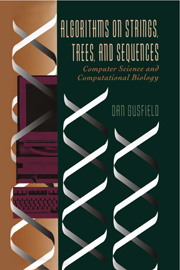Book contents
- Frontmatter
- Contents
- Preface
- I Exact String Matching: The Fundamental String Problem
- II Suffix Trees and Their Uses
- III Inexact Matching, Sequence Alignment, Dynamic Programming
- 10 The Importance of (Sub)sequence Comparison in Molecular Biology
- 11 Core String Edits, Alignments, and Dynamic Programming
- 12 Refining Core String Edits and Alignments
- 13 Extending the Core Problems
- 14 Multiple String Comparison – The Holy Grail
- 15 Sequence Databases and Their Uses – The Mother Lode
- IV Currents, Cousins, and Cameos
- Epilogue – where next?
- Bibliography
- Glossary
- Index
15 - Sequence Databases and Their Uses – The Mother Lode
from III - Inexact Matching, Sequence Alignment, Dynamic Programming
Published online by Cambridge University Press: 23 June 2010
- Frontmatter
- Contents
- Preface
- I Exact String Matching: The Fundamental String Problem
- II Suffix Trees and Their Uses
- III Inexact Matching, Sequence Alignment, Dynamic Programming
- 10 The Importance of (Sub)sequence Comparison in Molecular Biology
- 11 Core String Edits, Alignments, and Dynamic Programming
- 12 Refining Core String Edits and Alignments
- 13 Extending the Core Problems
- 14 Multiple String Comparison – The Holy Grail
- 15 Sequence Databases and Their Uses – The Mother Lode
- IV Currents, Cousins, and Cameos
- Epilogue – where next?
- Bibliography
- Glossary
- Index
Summary
We now turn to the dominant, most mature and most successful application of string algorithms in computational biology: the building and searching of databases holding molecular sequence data. We start by illustrating some uses of sequence databases and by describing a bit about existing databases. The impact of database searching (and expectations of greater future impact), explains a large part of the interest among biologists for algorithms that search, manipulate and compare strings. In turn, the biologists' activities have stimulated additional interest in string algorithms among computer scientists.
After describing the “why” and the “what” of sequence databases, we will discuss some “how” issues in string algorithms that are particular to database organization and search.
Why sequence databases?
Comprehensive databases/archives holding DNA and protein sequences are firmly established as central tools in current molecular biology – “electronic databases are fast becoming the lifeblood of the field” [452]. The fundamental reason is the power of biomolecular sequence comparison. This was made explicit in the first fact of biological sequence analysis (Chapter 10, page 212). Given the effectiveness of sequence comparison in molecular biology, it is natural to stockpile and systematically organize the biosequences to be compared; this has naturally led to the growth of sequence databases. We start this chapter with a few illustrations of the power of sequence comparison in the form of sequence database search.
Information
- Type
- Chapter
- Information
- Algorithms on Strings, Trees, and SequencesComputer Science and Computational Biology, pp. 370 - 392Publisher: Cambridge University PressPrint publication year: 1997
